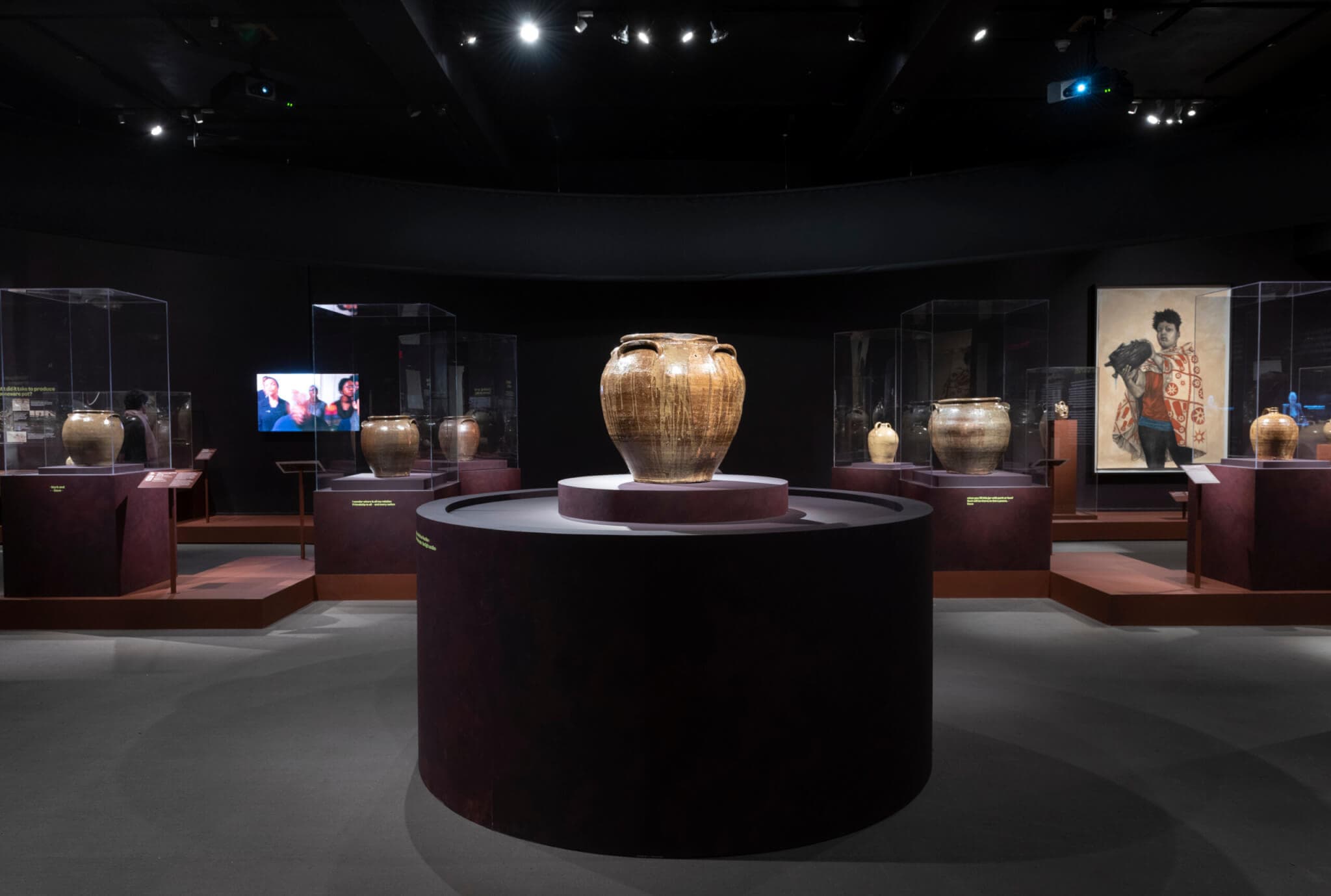“Hear Me Now: The Black Potters of Old Edgefield, South Carolina,” on view at the Museum of Fine Arts, Boston, features approximately sixty ceramic pieces created by enslaved potters throughout the nineteenth century, a wide range of jars, pots, jugs, bowls, and other vessels exhibited alongside the work of contemporary artists responding to this complex history of subjugation and creativity.
Set hip high in a dark-walled, spotlit room—a presentation that stands in stark contrast to the Met’s earlier, airy installation—the vessels are available for close inspection, and visitors can examine them from a 360-degree angle, taking every detail. Each piece showcases not only the artists’ creativity, resilience, and strength, but also the identities they still honored, despite the oppressive circumstances under which they lived.
The pottery in “Hear Me Now” feels exceptionally intimate; the clay was developed by enslaved people’s hands, their fingerprints leaving indents in the surface. The artists worked with water and clay from the local environment, and likely used the finished products in everyday activities.
Allowing visitors to see these intimacies up close is part of what makes the exhibit so extraordinary and allows us to feel closer to those who created the works, whether it be a sense of community, kinship, empathy and compassion, or awe that craftsmanship and creativity were able to blossom in even the harshest of soils.
Most prolific among the potters included in the exhibit is David Drake, known as “Dave,” who was an enslaved potter and poet. He inscribed his mononym on his works, as well as his own poetry verses. Drake was among the estimated 10 percent of literate enslaved Americans. Many states prohibited education for enslaved people, with South Carolina being the first state to institute such legislation in 1740. Slavers, operating within a blatantly and systemically white supremacist government, were fearful of slave rebellions or uprisings and worked to enforce measures preventing any form of collective organization or empowerment amongst enslaved communities.
Although Drake’s name and work are preserved through this collection, there are many artists we can’t identify. For each piece whose maker was lost —to time, to the relentless oppression of slavery and white supremacy—the accompanying placard reads “potter once known.” It is a tangible reminder that these artists existed as real and full people, whose hands shaped the clay and whose arms carried the finished stoneware to collect water, to cook over a fire, to share a meal.
The exhibition also presents nineteen unique face vessels, arranged along the walls. These were created by enslaved potters for their personal use, many likely inspired by ritualistic West African masks. As historian Wayne O’Bryant explains during the exhibit audio tour, the face vessels are relatively unique to Edgefield, the creation of those smuggled into the county by slaver Charles Lamar, who abducted hundreds of people from the Congo area in 1858—nearly fifty years after the transatlantic slave trade was abolished.
The vessels are made from kaolin clay, an abundant material in the American South. They come in a variety of sizes and shapes, but each depicts a face, teeth often bared in a smile or a grimace. The wide eyes and expressive eyebrows add character and render feeling, along with the carved ears included on most of the vessels, formed either close to the head or standing prominently out to the side like jug handles.
Every detail adds to the personality and vibrancy of the faces, inviting the viewer to connect and engage with them—and to the artists who shaped them. The vessels are personal expressions of faith and religion, culture, and connection to the peoples and countries from which the artists were forcibly abducted. Although their physical connection was severed, their tenacity to continue creating shows a deep and enduring link to their true heritage and roots.
Such deep connections to the past inspired many of the contemporary artists featured in the exhibit alongside the nearly two-hundred-year-old pottery pieces. Some, such as Robert Pruitt’s 2019 drawing Birth and Rebirth and Rebirth, engage in the theme through a different medium, while others, such as sculptor Simone Leigh’s Jug (2022)—the sisters of which are currently on view at the ICA—and Adebunmi Gbadebo’s K.S. (2021) make use of similar forms.
Gbadebo, herself a descendent of enslaved people on the True Blue Plantation in Fort Motte, South Carolina, created K.S. with True Blue Plantation cemetery soil and human locs. K.S. is the inscription carved into one of the headstones in the cemetery.
In the audio tour of the exhibit, Gbadebo said she was moved to make her work from the same land on which her ancestors were enslaved and now buried. She dug up soil from the cemetery and brought it to her Philadelphia studio and combined it with locs donated by Aaron Wilson Watson, Kelsey Jackson, and Cheryl Person.
Contemporary works such as Gbadebo’s represent a throughline to the past and into the present—and indeed stretching into the future. The heritage on display is not just about understanding those who came before us, but what we must continue to grapple with, to understand, and to live through, together.
“Hear Me Now: The Black Potters of Old Edgefield, South Carolina” is on view at the MFA Boston through June 9, 2023.




